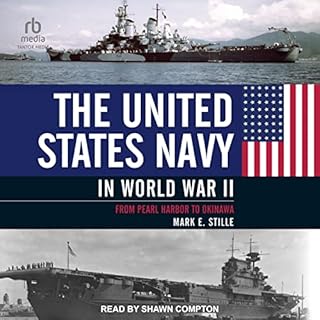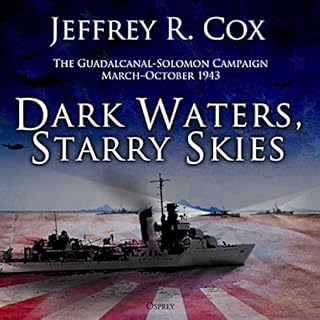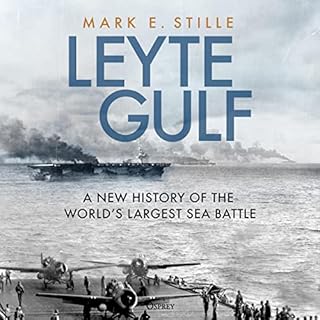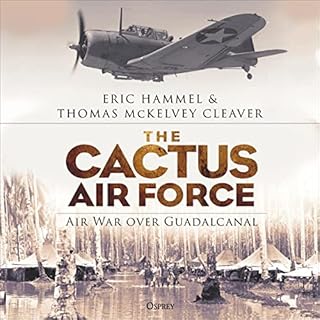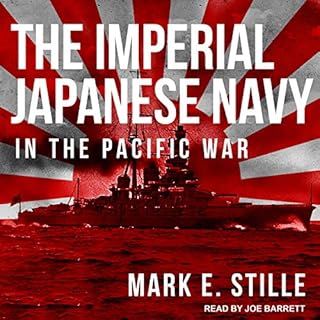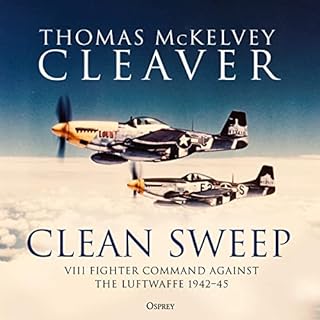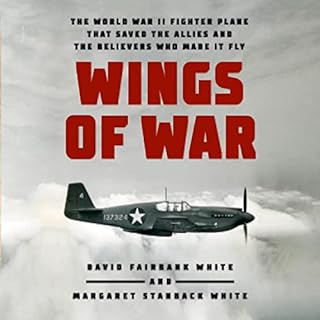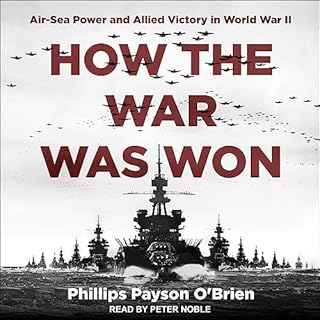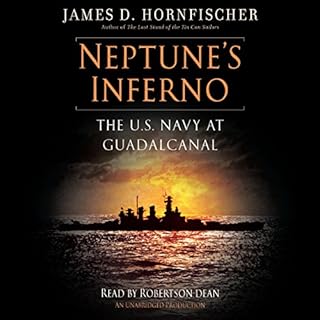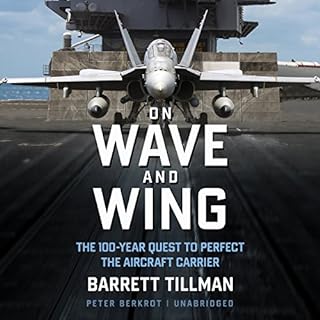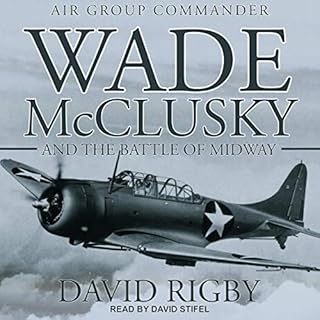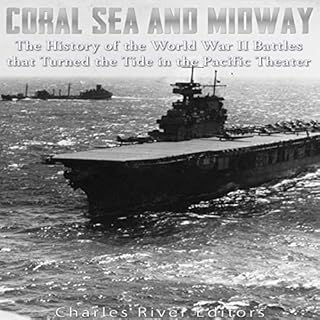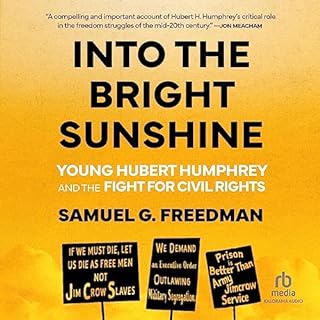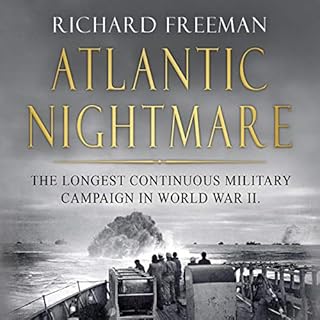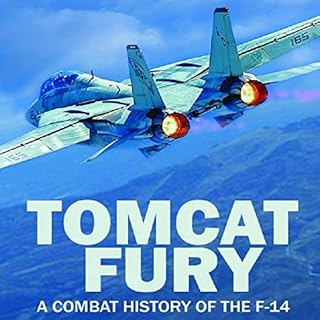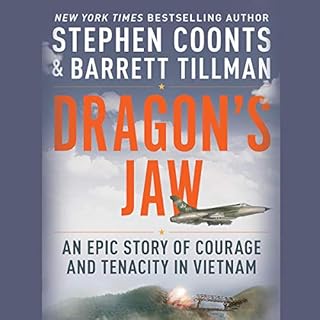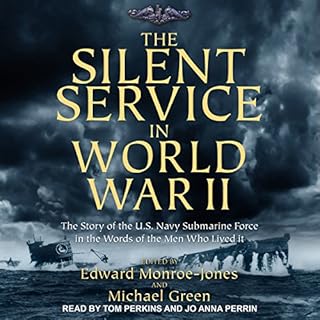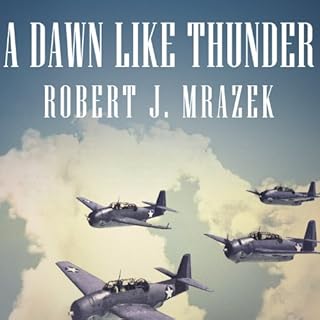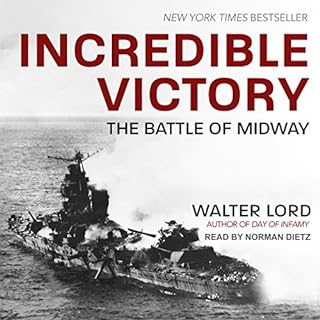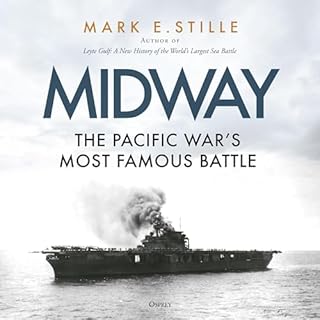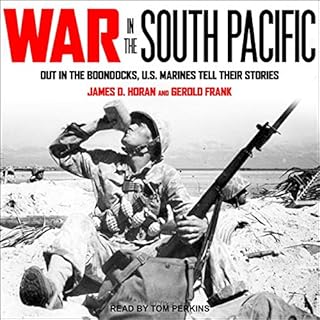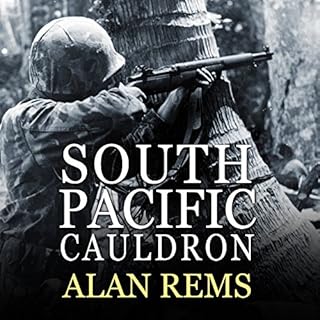
Pacific Carrier War
Carrier Combat from Pearl Harbor to Okinawa
Failed to add items
Add to Cart failed.
Add to Wish List failed.
Remove from wishlist failed.
Adding to library failed
Follow podcast failed
Unfollow podcast failed
Buy for $21.49
No default payment method selected.
We are sorry. We are not allowed to sell this product with the selected payment method
-
Narrated by:
-
Christopher Douyard
-
By:
-
Mark E. Stille
About this listen
A detailed and comprehensive study of the carrier formations of the Pacific War, including their origins, development, and key battles from the Coral Sea, through Midway and Guadalcanal to the battle of the Philippine Sea.
The defining feature of the Pacific Theater of World War II was the clash of carriers that ultimately decided the fate of nations. The names of the battles become legendary as some of the most epic encounters in the history of naval warfare. Pre-war assumptions about the impact and effectiveness of carriers were comprehensively tested in early war battles such as Coral Sea, while US victories at Midway and in the waters around Guadalcanal established the supremacy of its carriers. The US Navy's ability to adapt and evolve to the changing conditions of war maintained and furthered their advantage, culminating in their comprehensive victory at the battle of the Philippine Sea, history's largest carrier battle, which destroyed almost the entire Japanese carrier force.
Examining the ships, aircraft, and doctrines of both the Japanese and US navies and how they changed during the war, Mark E. Stille shows how the domination of American carriers paved the way towards the Allied victory in the Pacific.
©2021 Mark E. Stille (P)2022 TantorListeners also enjoyed...
-
The United States Navy in World War II
- From Pearl Harbor to Okinawa
- By: Mark E. Stille
- Narrated by: Shawn Compton
- Length: 9 hrs and 59 mins
- Unabridged
-
Overall2.5 out of 5 stars 2
-
Performance2.5 out of 5 stars 2
-
Story2.5 out of 5 stars 2
Although slowly building its navy while neutral during the early years of World War II, the US was struck a serious blow when its battleships, the lynchpin of US naval doctrine, were the target of the dramatic attack at Pearl Harbor.
-
1 out of 5 stars
-
The Ship Builders Gazette
- By Mary P. Rutherfurd on 02-25-24
By: Mark E. Stille
-
Dark Waters, Starry Skies
- The Guadalcanal-Solomons Campaign, March–October 1943
- By: Jeffrey Cox
- Narrated by: John Chancer
- Length: 31 hrs and 15 mins
- Unabridged
-
Overall4.5 out of 5 stars 76
-
Performance4.5 out of 5 stars 65
-
Story4.5 out of 5 stars 64
Thousands of miles from friendly ports, the US Navy had finally managed to complete the capture of Guadalcanal from the Japanese in early 1943. Now the Allies sought to keep the offensive momentum won at such a high cost. This is the central plotline running through this page-turning history beginning with the Japanese Operation I-Go and the American ambush of Admiral Yamamoto and continuing on to the Allied invasion of New Georgia, northwest of Guadalcanal in the middle of the Solomon Islands and the location of a major Japanese base.
-
4 out of 5 stars
-
great but way too much alliteration...
- By Greg on 06-16-23
By: Jeffrey Cox
-
Leyte Gulf
- A New History of the World's Largest Sea Battle
- By: Mark E. Stille
- Narrated by: John Chancer
- Length: 14 hrs and 14 mins
- Unabridged
-
Overall4.5 out of 5 stars 55
-
Performance4.5 out of 5 stars 50
-
Story4.5 out of 5 stars 50
Pacific War expert Mark Stille examines the key aspects of battle of Leyte Gulf, the largest naval encounter in history and probably the most decisive naval battle of the entire Pacific War, with new and insightful analysis and dismantles the myths surrounding the respective actions and overall performances of the two most important commanders in the battle, and the “lost victory” of the Japanese advance into Leyte Gulf that never happened.
-
4 out of 5 stars
-
Perhaps a little scholarly
- By Michael Kiehn on 11-14-24
By: Mark E. Stille
-
The Cactus Air Force
- Air War Over Guadalcanal
- By: Eric Hammel, Thomas McKelvey Cleaver
- Narrated by: Adam Henderson
- Length: 14 hrs and 40 mins
- Unabridged
-
Overall4.5 out of 5 stars 146
-
Performance4.5 out of 5 stars 127
-
Story4.5 out of 5 stars 127
In The Cactus Air Force, Pacific War expert Thomas McKelvey Cleaver worked closely with Eric to build on his collection of diary entries, interviews and first-hand accounts to create a vivid narrative of the struggle in the air over the island of Guadalcanal between August 20 and November 15, 1942.
-
5 out of 5 stars
-
Excellent Book!
- By Eric Peterson on 09-16-22
By: Eric Hammel, and others
-
The Imperial Japanese Navy in the Pacific War
- By: Mark E. Stille
- Narrated by: Joe Barrett
- Length: 11 hrs and 17 mins
- Unabridged
-
Overall4 out of 5 stars 91
-
Performance4.5 out of 5 stars 84
-
Story4 out of 5 stars 83
The Imperial Japanese Navy (IJN) was the third most powerful navy in the world at the start of World War II and came to dominate the Pacific in the early months of the war. This was a remarkable turnaround for a navy that only began to modernize in 1868. The Imperial Japanese Navy in the Pacific War details the Japanese ships which fought in the Pacific and examines the principles on which they were designed, how they were armed, when and where they were deployed, and how effective they were in battle.
-
5 out of 5 stars
-
Great Technical Reference
- By Dale H. Reeck on 06-09-18
By: Mark E. Stille
-
Clean Sweep
- VIII Fighter Command Against the Luftwaffe, 1942–45
- By: Thomas McKelvey Cleaver, BrigGen Clarence E. "Bud" Anderson USAF (Ret.) - foreword
- Narrated by: Lance C. Fuller
- Length: 18 hrs and 23 mins
- Unabridged
-
Overall4.5 out of 5 stars 58
-
Performance4.5 out of 5 stars 54
-
Story4.5 out of 5 stars 54
On August 7, 1942, two events of major military importance occurred on separate sides of the planet. In the South Pacific, the United States went on the offensive, landing the First Marine Division at Guadalcanal. In England, 12 B-17 bombers of the new Eighth Air Force’s 97th Bombardment Group bombed the Rouen–Sotteville railroad marshalling yards in France. While the mission was small, the aerial struggle that began that day would ultimately cost the United States more men killed and wounded by the end of the war in Europe than the Marines would lose in the Pacific War.
-
3 out of 5 stars
-
may be factual but poorly written
- By Bill Mackey on 01-08-24
By: Thomas McKelvey Cleaver, and others
-
The United States Navy in World War II
- From Pearl Harbor to Okinawa
- By: Mark E. Stille
- Narrated by: Shawn Compton
- Length: 9 hrs and 59 mins
- Unabridged
-
Overall2.5 out of 5 stars 2
-
Performance2.5 out of 5 stars 2
-
Story2.5 out of 5 stars 2
Although slowly building its navy while neutral during the early years of World War II, the US was struck a serious blow when its battleships, the lynchpin of US naval doctrine, were the target of the dramatic attack at Pearl Harbor.
-
1 out of 5 stars
-
The Ship Builders Gazette
- By Mary P. Rutherfurd on 02-25-24
By: Mark E. Stille
-
Dark Waters, Starry Skies
- The Guadalcanal-Solomons Campaign, March–October 1943
- By: Jeffrey Cox
- Narrated by: John Chancer
- Length: 31 hrs and 15 mins
- Unabridged
-
Overall4.5 out of 5 stars 76
-
Performance4.5 out of 5 stars 65
-
Story4.5 out of 5 stars 64
Thousands of miles from friendly ports, the US Navy had finally managed to complete the capture of Guadalcanal from the Japanese in early 1943. Now the Allies sought to keep the offensive momentum won at such a high cost. This is the central plotline running through this page-turning history beginning with the Japanese Operation I-Go and the American ambush of Admiral Yamamoto and continuing on to the Allied invasion of New Georgia, northwest of Guadalcanal in the middle of the Solomon Islands and the location of a major Japanese base.
-
4 out of 5 stars
-
great but way too much alliteration...
- By Greg on 06-16-23
By: Jeffrey Cox
-
Leyte Gulf
- A New History of the World's Largest Sea Battle
- By: Mark E. Stille
- Narrated by: John Chancer
- Length: 14 hrs and 14 mins
- Unabridged
-
Overall4.5 out of 5 stars 55
-
Performance4.5 out of 5 stars 50
-
Story4.5 out of 5 stars 50
Pacific War expert Mark Stille examines the key aspects of battle of Leyte Gulf, the largest naval encounter in history and probably the most decisive naval battle of the entire Pacific War, with new and insightful analysis and dismantles the myths surrounding the respective actions and overall performances of the two most important commanders in the battle, and the “lost victory” of the Japanese advance into Leyte Gulf that never happened.
-
4 out of 5 stars
-
Perhaps a little scholarly
- By Michael Kiehn on 11-14-24
By: Mark E. Stille
-
The Cactus Air Force
- Air War Over Guadalcanal
- By: Eric Hammel, Thomas McKelvey Cleaver
- Narrated by: Adam Henderson
- Length: 14 hrs and 40 mins
- Unabridged
-
Overall4.5 out of 5 stars 146
-
Performance4.5 out of 5 stars 127
-
Story4.5 out of 5 stars 127
In The Cactus Air Force, Pacific War expert Thomas McKelvey Cleaver worked closely with Eric to build on his collection of diary entries, interviews and first-hand accounts to create a vivid narrative of the struggle in the air over the island of Guadalcanal between August 20 and November 15, 1942.
-
5 out of 5 stars
-
Excellent Book!
- By Eric Peterson on 09-16-22
By: Eric Hammel, and others
-
The Imperial Japanese Navy in the Pacific War
- By: Mark E. Stille
- Narrated by: Joe Barrett
- Length: 11 hrs and 17 mins
- Unabridged
-
Overall4 out of 5 stars 91
-
Performance4.5 out of 5 stars 84
-
Story4 out of 5 stars 83
The Imperial Japanese Navy (IJN) was the third most powerful navy in the world at the start of World War II and came to dominate the Pacific in the early months of the war. This was a remarkable turnaround for a navy that only began to modernize in 1868. The Imperial Japanese Navy in the Pacific War details the Japanese ships which fought in the Pacific and examines the principles on which they were designed, how they were armed, when and where they were deployed, and how effective they were in battle.
-
5 out of 5 stars
-
Great Technical Reference
- By Dale H. Reeck on 06-09-18
By: Mark E. Stille
-
Clean Sweep
- VIII Fighter Command Against the Luftwaffe, 1942–45
- By: Thomas McKelvey Cleaver, BrigGen Clarence E. "Bud" Anderson USAF (Ret.) - foreword
- Narrated by: Lance C. Fuller
- Length: 18 hrs and 23 mins
- Unabridged
-
Overall4.5 out of 5 stars 58
-
Performance4.5 out of 5 stars 54
-
Story4.5 out of 5 stars 54
On August 7, 1942, two events of major military importance occurred on separate sides of the planet. In the South Pacific, the United States went on the offensive, landing the First Marine Division at Guadalcanal. In England, 12 B-17 bombers of the new Eighth Air Force’s 97th Bombardment Group bombed the Rouen–Sotteville railroad marshalling yards in France. While the mission was small, the aerial struggle that began that day would ultimately cost the United States more men killed and wounded by the end of the war in Europe than the Marines would lose in the Pacific War.
-
3 out of 5 stars
-
may be factual but poorly written
- By Bill Mackey on 01-08-24
By: Thomas McKelvey Cleaver, and others
-
Nimitz at War
- Command Leadership from Pearl Harbor to Tokyo Bay
- By: Craig L. Symonds
- Narrated by: L.J. Ganser
- Length: 14 hrs and 26 mins
- Unabridged
-
Overall5 out of 5 stars 455
-
Performance5 out of 5 stars 393
-
Story5 out of 5 stars 391
Only days after the Japanese attacked Pearl Harbor, President Franklin D. Roosevelt tapped Chester W. Nimitz to assume command of the Pacific Fleet. Nimitz transformed the devastated and dispirited Pacific fleet into the most powerful and commanding naval force in history. Facing demands from Washington to mount an early offensive, he had first to revive the depressed morale of the thousands of sailors, soldiers, and Marines who served under him. And of course, he also confronted a formidable and implacable enemy in the Imperial Japanese Navy.
-
4 out of 5 stars
-
Great
- By Jean on 12-14-22
By: Craig L. Symonds
-
Wings of War
- The World War II Fighter Plane That Saved the Allies and the Believers Who Made It Fly
- By: David Fairbank White, Margaret Stanback White
- Narrated by: René Ruiz
- Length: 9 hrs and 24 mins
- Unabridged
-
Overall4.5 out of 5 stars 85
-
Performance5 out of 5 stars 79
-
Story4.5 out of 5 stars 79
Wings of War is the incredible true story of the P-51 Mustang fighter and the unlikely crew of designers, engineers, test pilots, and army officers who brought it from the drafting table to the skies over World War II. This is hardly a straightforward tale of building an airplane—for years, the team was stymied by corruption within the defense industry and stonewalled by the Army Air Forces, who failed to understand the Mustang’s potential.
-
3 out of 5 stars
-
Disappointed
- By David Kocol on 06-22-23
By: David Fairbank White, and others
-
To the End of the Earth
- The US Army and the Downfall of Japan, 1945
- By: John C. McManus
- Narrated by: Walter Dixon
- Length: 15 hrs and 46 mins
- Unabridged
-
Overall5 out of 5 stars 48
-
Performance4.5 out of 5 stars 46
-
Story4.5 out of 5 stars 46
The dawn of 1945 finds a US Army at its peak in the Pacific. Allied victory over Japan is all but assured. The only question is how many more months—or years—of fight does the enemy have left. John C. McManus’s magisterial series, described by the Wall Street Journal as being “as vast and splendid as Rick Atkinson’s Pulitzer Prize-winning Liberation Trilogy,” returns with this brilliant final volume.
-
5 out of 5 stars
-
Amazing history
- By sammy on 02-26-24
By: John C. McManus
-
How the War Was Won
- Air-Sea Power and Allied Victory in World War II
- By: Phillips Payson O'Brien
- Narrated by: Peter Noble
- Length: 22 hrs and 57 mins
- Unabridged
-
Overall4.5 out of 5 stars 38
-
Performance4.5 out of 5 stars 35
-
Story4.5 out of 5 stars 35
World War II is usually seen as a titanic land battle, decided by mass armies, most importantly those on the Eastern Front. Phillips Payson O'Brien shows us the war in a completely different light. In this compelling new history of the Allied path to victory, he argues that in terms of production, technology, and economic power, the war was far more a contest of air and sea than of land supremacy.
-
4 out of 5 stars
-
Excellent history, but repetitive
- By Anna S. on 11-26-23
-
Pax
- War and Peace in Rome's Golden Age
- By: Tom Holland
- Narrated by: Tom Holland
- Length: 14 hrs and 53 mins
- Unabridged
-
Overall5 out of 5 stars 210
-
Performance5 out of 5 stars 201
-
Story5 out of 5 stars 201
The Pax Romana has long been shorthand for the empire’s golden age. Stretching from Caledonia to Arabia, Rome ruled over a quarter of the world’s population. It was the wealthiest and most formidable state in the history of humankind. Pax is a captivating narrative history of Rome at the height of its power. From the gilded capital to realms beyond the frontier, historian Tom Holland shows ancient Rome in all its glory
-
5 out of 5 stars
-
Great book!
- By Mic on 09-27-23
By: Tom Holland
-
Duel of Eagles
- The Classic Account of the Battle of Britain
- By: Peter Townsend
- Narrated by: Jonathan Cowley
- Length: 20 hrs and 2 mins
- Unabridged
-
Overall4 out of 5 stars 5
-
Performance3.5 out of 5 stars 3
-
Story5 out of 5 stars 3
In May 1940, Group Captain Peter Townsend took command of 85 Squadron, tasked with preparing it for the defense of Great Britain against German bombers. It was the beginning of the long, hot, lethal summer in which the RAF and the Luftwaffe fought to the death over England in the furious conflict which ultimately saved Britain from Nazi invasion. Peter Townsend's epic Duel of Eagles is widely acknowledged as the classic account of the Battle of Britain—the desperate, defining clash which would become one of the greatest triumphs in British military history.
-
3 out of 5 stars
-
Excellent book, sing-song delivery
- By Margaret French on 02-04-23
By: Peter Townsend
-
Neptune's Inferno
- The U.S. Navy at Guadalcanal
- By: James D. Hornfischer
- Narrated by: Robertson Dean
- Length: 18 hrs and 38 mins
- Unabridged
-
Overall5 out of 5 stars 2,370
-
Performance5 out of 5 stars 2,044
-
Story5 out of 5 stars 2,041
With The Last Stand of the Tin Can Sailors and Ship of Ghosts, James D. Hornfischer created essential and enduring narratives about America’s World War II Navy, works of unique immediacy distinguished by rich portraits of ordinary men in extremis and exclusive new information. Now he does the same for the deadliest, most pivotal naval campaign of the Pacific war: Guadalcanal. Neptune’s Inferno is at once the most epic and the most intimate account ever written of the contest for control of the seaways of the Solomon Islands.
-
5 out of 5 stars
-
The WWII Pacific Theater Explodes In My Lazy Chair
- By Rum Runner on 03-01-11
-
The Story of World War II
- By: Donald L. Miller, Henry Steele Commager
- Narrated by: Michael Kramer
- Length: 24 hrs and 52 mins
- Unabridged
-
Overall4.5 out of 5 stars 3,855
-
Performance4.5 out of 5 stars 3,478
-
Story5 out of 5 stars 3,463
Drawing on previously unpublished eyewitness accounts, prizewinning historian Donald L. Miller has written what critics are calling one of the most powerful accounts of warfare ever published. Here are the horror and heroism of World War II in the words of the men who fought it, the journalists who covered it, and the civilians who were caught in its fury. Miller gives us an up-close, deeply personal view of a war that was more savagely fought - and whose outcome was in greater doubt - than one might imagine. This is the war that Americans on the home front would have read about had they had access to previously censored testimony.
-
5 out of 5 stars
-
INCREDIBLE! WELL-RESEARCHED, COMPLETE & UNBIASED!
- By The Louligan on 07-15-14
By: Donald L. Miller, and others
-
Who Can Hold the Sea
- The U.S. Navy in the Cold War 1945-1960
- By: James D. Hornfischer
- Narrated by: Christopher Newton, Sharon Hornfischer
- Length: 17 hrs and 56 mins
- Unabridged
-
Overall4.5 out of 5 stars 291
-
Performance5 out of 5 stars 247
-
Story4.5 out of 5 stars 246
This landmark account of the U.S. Navy in the Cold War, Who Can Hold the Sea combines narrative history with scenes of stirring adventure on—and under—the high seas. In 1945, at the end of World War II, the victorious Navy sends its sailors home and decommissions most of its warships. But this peaceful interlude is short-lived, as Stalin, America’s former ally, makes aggressive moves in Europe and the Far East.
-
5 out of 5 stars
-
James D. Hornfisher's last work
- By JWHayn4563 on 05-05-22
-
Tank Warfare on the Eastern Front, 1941-1942
- Schwerpunkt
- By: Robert A. Forczyk
- Narrated by: P.J. Ochlan
- Length: 16 hrs and 10 mins
- Unabridged
-
Overall4.5 out of 5 stars 30
-
Performance4.5 out of 5 stars 28
-
Story4.5 out of 5 stars 28
Robert Forczyk's incisive study offers fresh insight into how the two most powerful mechanized armies of WWII developed their tactics and weaponry during the early years of the Russo-German War. He uses German, Russian, and English sources to provide the first comprehensive overview and analysis of armored warfare from the German and Soviet perspectives.
-
5 out of 5 stars
-
A Great work on tank warfare
- By Anonymous User on 03-22-24
-
Tower of Skulls
- A History of the Asia-Pacific War, Vol. 1 (July 1937 - May 1942)
- By: Richard B. Frank
- Narrated by: L. J. Ganser
- Length: 26 hrs and 23 mins
- Unabridged
-
Overall4.5 out of 5 stars 307
-
Performance5 out of 5 stars 265
-
Story5 out of 5 stars 261
This story casts penetrating light on how struggles in Europe and Asia merged into a tightly entwined global war. It features not just battles, but also the sweeping political, economic, and social effects of the war, and are graced with a rich tapestry of individual characters from top-tier political and military figures down to ordinary servicemen, as well as the accounts of civilians of all races and ages.
-
5 out of 5 stars
-
Outstanding
- By Patrick on 03-16-20
By: Richard B. Frank
-
Pacific Crucible: War at Sea in the Pacific, 1941-1942
- By: Ian W. Toll
- Narrated by: Grover Gardner
- Length: 22 hrs and 6 mins
- Unabridged
-
Overall5 out of 5 stars 3,976
-
Performance5 out of 5 stars 3,546
-
Story5 out of 5 stars 3,531
On the first Sunday in December 1941, an armada of Japanese warplanes appeared suddenly over Pearl Harbor, Hawaii, and devastated the U.S. Pacific Fleet. Six months later, in a sea fight north of the tiny atoll of Midway, four Japanese aircraft carriers were sent into the abyss. Pacific Crucible tells the epic tale of these first searing months of the Pacific war, when the U.S. Navy shook off the worst defeat in American military history and seized the strategic initiative.
-
5 out of 5 stars
-
Astonishingly good.
- By Mike From Mesa on 09-01-12
By: Ian W. Toll
Related to this topic
-
Rising Sun, Falling Skies
- The Disastrous Java Sea Campaign of World War II
- By: Jeffrey Cox
- Narrated by: Theodore O'Brien
- Length: 22 hrs and 49 mins
- Unabridged
-
Overall4.5 out of 5 stars 119
-
Performance4.5 out of 5 stars 103
-
Story5 out of 5 stars 102
Few events have ever shaken a country in the way that the Japanese attack on Pearl Harbor affected the United States. After the devastating attack, Japanese forces continued to overwhelm the Allies, attacking Malaya with its fortress of Singapore, and taking resource-rich islands in the Pacific - Borneo, Sumatra, and Java - in their own blitzkrieg offensive. Allied losses in these early months after America's entry into the war were great, and among the most devastating were those suffered during the Java Sea Campaign.
-
5 out of 5 stars
-
The first months of the war were frightening.
- By michael s on 10-07-22
By: Jeffrey Cox
-
I Will Run Wild
- The Pacific War from Pearl Harbor to Midway
- By: Thomas McKelvey Cleaver
- Narrated by: Lance C Fuller
- Length: 12 hrs and 27 mins
- Unabridged
-
Overall4.5 out of 5 stars 93
-
Performance4.5 out of 5 stars 82
-
Story4.5 out of 5 stars 82
In many popular histories of the Pacific War, the period from the Japanese attack at Pearl Harbor to the US victory at Midway is often passed over because it is seen as a period of darkness. Indeed, it is easy to see the period as one of unmitigated disaster for the Allies, with the fall of the Philippines, Malaya, Burma and the Dutch East Indies and the wholesale retreat and humiliation at the hands of Japan throughout Southeast Asia.
-
5 out of 5 stars
-
Very informative
- By dexter on 09-20-20
-
Under the Southern Cross
- The South Pacific Air Campaign Against Rabaul
- By: Thomas McKelvey Cleaver
- Narrated by: Lance C Fuller
- Length: 13 hrs and 22 mins
- Unabridged
-
Overall4.5 out of 5 stars 66
-
Performance4.5 out of 5 stars 60
-
Story4.5 out of 5 stars 60
From August 7th 1942 until February 24th 1944, the US Navy fought the most difficult campaign in its history. Between the landing of the 1st Marine Division on Guadalcanal and the final withdrawal of the Imperial Japanese Navy from its main South Pacific base at Rabaul, the US Navy suffered such high personnel losses that for years it refused to publicly release total casualty figures.
-
5 out of 5 stars
-
Another first class work by Thomas Cleaver.
- By Amazon Customer on 07-10-21
-
Blazing Star, Setting Sun
- The Guadalcanal-Solomons Campaign November 1942-March 1943
- By: Jeffrey Cox
- Narrated by: Lance C Fuller
- Length: 24 hrs and 58 mins
- Unabridged
-
Overall4.5 out of 5 stars 260
-
Performance4.5 out of 5 stars 226
-
Story4.5 out of 5 stars 224
By the end of February 1944, thanks to hard-fought and costly American victories in the first and second naval battles of Guadalcanal, the battle of Empress Augusta Bay and the battle of Cape St George, the Japanese would no longer hold the materiel or skilled manpower advantage. From this point on, although the war was still a long way from being won, the American star was unquestionably on the ascendant, slowly, but surely, edging Japanese imperialism towards its sunset.
-
3 out of 5 stars
-
Narrator Ruined the Book
- By Duncan on 08-20-20
By: Jeffrey Cox
-
How Carriers Fought
- Carrier Operations in WWII
- By: Lars Celander
- Narrated by: Sean Runnette
- Length: 11 hrs and 23 mins
- Unabridged
-
Overall4.5 out of 5 stars 105
-
Performance4.5 out of 5 stars 89
-
Story4.5 out of 5 stars 88
In November 1921, the first purpose-built aircraft carrier was launched by the Japanese, followed a year later by the launch of the British Hermes. The conversion of battle cruisers into aircraft carriers after World War I required the consideration of issues including handling aircraft on the flight deck and the techniques of attacking enemy ships, and the evolution of carrier operations was ongoing when World War II broke out.
-
3 out of 5 stars
-
Interesting but not mandatory
- By Thor Olson on 08-29-19
By: Lars Celander
-
War Beneath the Sea
- Submarine Conflict During World War II
- By: Peter Padfield
- Narrated by: Chris MacDonnell
- Length: 25 hrs and 1 min
- Unabridged
-
Overall4.5 out of 5 stars 163
-
Performance4.5 out of 5 stars 141
-
Story4.5 out of 5 stars 140
This riveting chronicle of submarine warfare is the first to cover all the major submarine campaigns of the war, describing, in detail, the operations of the British, American, Japanese, Italian, and German submarine and anti-submarine forces. Beginning with a vivid re-creation of the sinking of the passenger liner Athenia by a German U-boat in September 1939, critically acclaimed military historian Peter Padfield's compelling narrative casts an unflinching eye on the devastating consequences of maritime warfare.
-
5 out of 5 stars
-
Fills in the gaps of other submarine books
- By Ben on 05-19-21
By: Peter Padfield
-
Rising Sun, Falling Skies
- The Disastrous Java Sea Campaign of World War II
- By: Jeffrey Cox
- Narrated by: Theodore O'Brien
- Length: 22 hrs and 49 mins
- Unabridged
-
Overall4.5 out of 5 stars 119
-
Performance4.5 out of 5 stars 103
-
Story5 out of 5 stars 102
Few events have ever shaken a country in the way that the Japanese attack on Pearl Harbor affected the United States. After the devastating attack, Japanese forces continued to overwhelm the Allies, attacking Malaya with its fortress of Singapore, and taking resource-rich islands in the Pacific - Borneo, Sumatra, and Java - in their own blitzkrieg offensive. Allied losses in these early months after America's entry into the war were great, and among the most devastating were those suffered during the Java Sea Campaign.
-
5 out of 5 stars
-
The first months of the war were frightening.
- By michael s on 10-07-22
By: Jeffrey Cox
-
I Will Run Wild
- The Pacific War from Pearl Harbor to Midway
- By: Thomas McKelvey Cleaver
- Narrated by: Lance C Fuller
- Length: 12 hrs and 27 mins
- Unabridged
-
Overall4.5 out of 5 stars 93
-
Performance4.5 out of 5 stars 82
-
Story4.5 out of 5 stars 82
In many popular histories of the Pacific War, the period from the Japanese attack at Pearl Harbor to the US victory at Midway is often passed over because it is seen as a period of darkness. Indeed, it is easy to see the period as one of unmitigated disaster for the Allies, with the fall of the Philippines, Malaya, Burma and the Dutch East Indies and the wholesale retreat and humiliation at the hands of Japan throughout Southeast Asia.
-
5 out of 5 stars
-
Very informative
- By dexter on 09-20-20
-
Under the Southern Cross
- The South Pacific Air Campaign Against Rabaul
- By: Thomas McKelvey Cleaver
- Narrated by: Lance C Fuller
- Length: 13 hrs and 22 mins
- Unabridged
-
Overall4.5 out of 5 stars 66
-
Performance4.5 out of 5 stars 60
-
Story4.5 out of 5 stars 60
From August 7th 1942 until February 24th 1944, the US Navy fought the most difficult campaign in its history. Between the landing of the 1st Marine Division on Guadalcanal and the final withdrawal of the Imperial Japanese Navy from its main South Pacific base at Rabaul, the US Navy suffered such high personnel losses that for years it refused to publicly release total casualty figures.
-
5 out of 5 stars
-
Another first class work by Thomas Cleaver.
- By Amazon Customer on 07-10-21
-
Blazing Star, Setting Sun
- The Guadalcanal-Solomons Campaign November 1942-March 1943
- By: Jeffrey Cox
- Narrated by: Lance C Fuller
- Length: 24 hrs and 58 mins
- Unabridged
-
Overall4.5 out of 5 stars 260
-
Performance4.5 out of 5 stars 226
-
Story4.5 out of 5 stars 224
By the end of February 1944, thanks to hard-fought and costly American victories in the first and second naval battles of Guadalcanal, the battle of Empress Augusta Bay and the battle of Cape St George, the Japanese would no longer hold the materiel or skilled manpower advantage. From this point on, although the war was still a long way from being won, the American star was unquestionably on the ascendant, slowly, but surely, edging Japanese imperialism towards its sunset.
-
3 out of 5 stars
-
Narrator Ruined the Book
- By Duncan on 08-20-20
By: Jeffrey Cox
-
How Carriers Fought
- Carrier Operations in WWII
- By: Lars Celander
- Narrated by: Sean Runnette
- Length: 11 hrs and 23 mins
- Unabridged
-
Overall4.5 out of 5 stars 105
-
Performance4.5 out of 5 stars 89
-
Story4.5 out of 5 stars 88
In November 1921, the first purpose-built aircraft carrier was launched by the Japanese, followed a year later by the launch of the British Hermes. The conversion of battle cruisers into aircraft carriers after World War I required the consideration of issues including handling aircraft on the flight deck and the techniques of attacking enemy ships, and the evolution of carrier operations was ongoing when World War II broke out.
-
3 out of 5 stars
-
Interesting but not mandatory
- By Thor Olson on 08-29-19
By: Lars Celander
-
War Beneath the Sea
- Submarine Conflict During World War II
- By: Peter Padfield
- Narrated by: Chris MacDonnell
- Length: 25 hrs and 1 min
- Unabridged
-
Overall4.5 out of 5 stars 163
-
Performance4.5 out of 5 stars 141
-
Story4.5 out of 5 stars 140
This riveting chronicle of submarine warfare is the first to cover all the major submarine campaigns of the war, describing, in detail, the operations of the British, American, Japanese, Italian, and German submarine and anti-submarine forces. Beginning with a vivid re-creation of the sinking of the passenger liner Athenia by a German U-boat in September 1939, critically acclaimed military historian Peter Padfield's compelling narrative casts an unflinching eye on the devastating consequences of maritime warfare.
-
5 out of 5 stars
-
Fills in the gaps of other submarine books
- By Ben on 05-19-21
By: Peter Padfield
-
On Wave and Wing
- The 100 Year Quest to Perfect the Aircraft Carrier
- By: Barrett Tillman
- Narrated by: Peter Berkrot
- Length: 9 hrs and 18 mins
- Unabridged
-
Overall4.5 out of 5 stars 188
-
Performance4 out of 5 stars 171
-
Story4.5 out of 5 stars 170
What defended the US after the attack on Pearl Harbor, defeated the Soviet Union in the Cold War, and is an essential tool in the fight against terror? Aircraft carriers. For 70 years, these ships remained a little-understood cornerstone of American power. In his latest book, On Wave and Wing, Barrett Tillman sheds light on the history of these floating leviathans and offers a nuanced analysis of the largest man-made vessel in the history of the world.
-
3 out of 5 stars
-
100th Anniversary of the Aircraft Carrier
- By Jean on 08-05-17
By: Barrett Tillman
-
Shattered Sword
- The Untold Story of the Battle of Midway
- By: Jonathan Parshall, Anthony Tully
- Narrated by: Tom Perkins
- Length: 24 hrs and 44 mins
- Unabridged
-
Overall4.5 out of 5 stars 2,040
-
Performance4.5 out of 5 stars 1,757
-
Story4.5 out of 5 stars 1,745
Many consider the Battle of Midway to have turned the tide of the Pacific War. It is without question one of the most famous battles in history. Now, for the first time since Gordon W. Prange's best-selling Miracle at Midway, Jonathan Parshall and Anthony Tully offer a new interpretation of this great naval engagement. Shattered Sword makes extensive use of Japanese primary sources. It also corrects the many errors of Mitsuo Fuchida's Midway: The Battle That Doomed Japan It thus forces a major, potentially controversial reevaluation of the great battle.
-
4 out of 5 stars
-
Shattered Myths - These authors got it right?
- By Ol'BlueEyes on 05-13-19
By: Jonathan Parshall, and others
-
The Imperial Japanese Navy in the Pacific War
- By: Mark E. Stille
- Narrated by: Joe Barrett
- Length: 11 hrs and 17 mins
- Unabridged
-
Overall4 out of 5 stars 91
-
Performance4.5 out of 5 stars 84
-
Story4 out of 5 stars 83
The Imperial Japanese Navy (IJN) was the third most powerful navy in the world at the start of World War II and came to dominate the Pacific in the early months of the war. This was a remarkable turnaround for a navy that only began to modernize in 1868. The Imperial Japanese Navy in the Pacific War details the Japanese ships which fought in the Pacific and examines the principles on which they were designed, how they were armed, when and where they were deployed, and how effective they were in battle.
-
5 out of 5 stars
-
Great Technical Reference
- By Dale H. Reeck on 06-09-18
By: Mark E. Stille
-
Wade McClusky and the Battle of Midway
- By: David Rigby
- Narrated by: David Stifel
- Length: 11 hrs and 40 mins
- Unabridged
-
Overall4.5 out of 5 stars 96
-
Performance4.5 out of 5 stars 83
-
Story4 out of 5 stars 83
The story of the man who won the battle of Midway and avenged Pearl Harbor for the United States. During the Battle of Midway in June 1942, US Navy dive bomber pilot Wade McClusky proved himself to be one of the greatest pilots and combat leaders in American history, but his story has never been told - until now.
-
2 out of 5 stars
-
This biographer is obsessed
- By J. S. Harbour on 05-17-20
By: David Rigby
-
Coral Sea and Midway
- The History of the World War II Battles That Turned the Tide in the Pacific Theater
- By: Charles River Editors
- Narrated by: Ken Teutsch
- Length: 2 hrs and 48 mins
- Unabridged
-
Overall4.5 out of 5 stars 31
-
Performance4.5 out of 5 stars 25
-
Story4.5 out of 5 stars 25
The growing buzz of aircraft engines disturbed the Japanese military construction personnel hauling equipment ashore on the beige coral sand of Tulagi Island at 8:20 AM on May 4th, 1942. Offshore, the large IJN (Imperial Japanese Navy) minelayer Okinoshima, flagship of Admiral Shima Kiyohide, lay at anchor, along with two destroyers, Kikuzuki and Yutsuki, and transport ships.
-
5 out of 5 stars
-
The Consummate Treatise
- By Sam on 11-23-20
-
Pacific Crucible: War at Sea in the Pacific, 1941-1942
- By: Ian W. Toll
- Narrated by: Grover Gardner
- Length: 22 hrs and 6 mins
- Unabridged
-
Overall5 out of 5 stars 3,976
-
Performance5 out of 5 stars 3,546
-
Story5 out of 5 stars 3,531
On the first Sunday in December 1941, an armada of Japanese warplanes appeared suddenly over Pearl Harbor, Hawaii, and devastated the U.S. Pacific Fleet. Six months later, in a sea fight north of the tiny atoll of Midway, four Japanese aircraft carriers were sent into the abyss. Pacific Crucible tells the epic tale of these first searing months of the Pacific war, when the U.S. Navy shook off the worst defeat in American military history and seized the strategic initiative.
-
5 out of 5 stars
-
Astonishingly good.
- By Mike From Mesa on 09-01-12
By: Ian W. Toll
-
Into the Bright Sunshine
- Young Hubert Humphrey and the Fight for Civil Rights (Pivotal Moments in American History Series)
- By: Samuel G. Freedman
- Narrated by: Mike Lenz
- Length: 17 hrs and 9 mins
- Unabridged
-
Overall4.5 out of 5 stars 15
-
Performance4 out of 5 stars 14
-
Story4.5 out of 5 stars 14
During one sweltering week in July 1948, the Democratic Party gathered in Philadelphia for its national convention. The most pressing and controversial issue facing the delegates was not whom to nominate for president—the incumbent, Harry Truman, was the presumptive candidate—but whether the Democrats would finally embrace the cause of civil rights and embed it in their official platform. On the convention's final day, Hubert Humphrey, the relatively obscure mayor of the midsized city of Minneapolis, ascended the podium.
-
4 out of 5 stars
-
Narrator bungles pronunciations
- By ARV on 09-23-23
-
Atlantic Nightmare
- The Longest Continuous Military Campaign in World War Ii
- By: Richard Freeman
- Narrated by: Will Huggins
- Length: 12 hrs and 9 mins
- Unabridged
-
Overall4.5 out of 5 stars 28
-
Performance4.5 out of 5 stars 23
-
Story4.5 out of 5 stars 23
No other battle of the Second World War lasted longer than the 2,075 days of the Battle of the Atlantic. It raged from the opening day of the war in September 1939 until it ended almost six years later with Germany’s surrender in May 1945. Vital supplies of food, fuel, and the raw materials needed by the Allies to wage war had to be transported in merchant ships in escorted convoys across the Atlantic Ocean, where they were at the mercy of German U-boats and warships.
-
2 out of 5 stars
-
Slanted Badly
- By Christopher on 07-07-24
By: Richard Freeman
-
Tomcat Fury
- A Combat History of the F-14
- By: Mike Guardia
- Narrated by: Johnny Heller
- Length: 4 hrs and 33 mins
- Unabridged
-
Overall4.5 out of 5 stars 77
-
Performance4.5 out of 5 stars 65
-
Story4.5 out of 5 stars 65
For more than three decades, the Grumman F-14 Tomcat was the US Navy’s premier carrier-based, multirole fighter jet. From its harrowing combat missions over Libya to its appearance on the silver screen in movies like Top Gun and Executive Decision, the F-14 has become an icon of American air power. Now, for the first time in a single volume, Tomcat Fury explores the illustrious combat history of the F-14, from the Gulf of Sidra to the Iran-Iraq War to the skies over Afghanistan in the Global War on Terror.
-
5 out of 5 stars
-
I read this when it came out, also good as an audio.
- By S. H. Moore on 08-18-20
By: Mike Guardia
-
Battle of Surigao Strait
- Twentieth-Century Battles
- By: Anthony P. Tully
- Narrated by: Gary Roelofs
- Length: 14 hrs and 34 mins
- Unabridged
-
Overall4 out of 5 stars 112
-
Performance3.5 out of 5 stars 101
-
Story4.5 out of 5 stars 102
Surigao Strait in the Philippine Islands was the scene of a major battleship duel during the Battle of Leyte Gulf. Because the battle was fought at night and had few survivors on the Japanese side, the events of that naval engagement have been passed down in garbled accounts. Anthony P. Tully pulls together all of the existing documentary material, including newly discovered accounts and a careful analysis of U.S. Navy action reports, to create a new and more detailed description of the action.
-
5 out of 5 stars
-
A Much Needed History!
- By Chiefkent on 09-09-14
By: Anthony P. Tully
-
The Cactus Air Force
- Air War Over Guadalcanal
- By: Eric Hammel, Thomas McKelvey Cleaver
- Narrated by: Adam Henderson
- Length: 14 hrs and 40 mins
- Unabridged
-
Overall4.5 out of 5 stars 146
-
Performance4.5 out of 5 stars 127
-
Story4.5 out of 5 stars 127
In The Cactus Air Force, Pacific War expert Thomas McKelvey Cleaver worked closely with Eric to build on his collection of diary entries, interviews and first-hand accounts to create a vivid narrative of the struggle in the air over the island of Guadalcanal between August 20 and November 15, 1942.
-
5 out of 5 stars
-
Excellent Book!
- By Eric Peterson on 09-16-22
By: Eric Hammel, and others
-
Dragon's Jaw
- An Epic Story of Courage and Tenacity in Vietnam
- By: Stephen Coonts, Barrett Tillman
- Narrated by: Dan Woren
- Length: 10 hrs and 52 mins
- Unabridged
-
Overall4.5 out of 5 stars 135
-
Performance5 out of 5 stars 120
-
Story4.5 out of 5 stars 120
Every war has its "bridge" - Old North Bridge at Concord, Burnside's Bridge at Antietam, the railway bridge over Burma's River Kwai, the bridge over Germany's Rhine River at Remagen, and the bridges over Korea's Toko Ri. In Vietnam it was the bridge at Thanh Hoa, called Dragon's Jaw. For seven long years hundreds of young US airmen flew sortie after sortie against North Vietnam's formidable and strategically important bridge, dodging a heavy concentration of anti-aircraft fire and enemy MiG planes. Many American airmen were shot down, killed, or captured....
-
3 out of 5 stars
-
At some point the political commentary is exhausting
- By Tyler White on 06-07-19
By: Stephen Coonts, and others
People who viewed this also viewed...
-
The Imperial Japanese Navy in the Pacific War
- By: Mark E. Stille
- Narrated by: Joe Barrett
- Length: 11 hrs and 17 mins
- Unabridged
-
Overall4 out of 5 stars 91
-
Performance4.5 out of 5 stars 84
-
Story4 out of 5 stars 83
The Imperial Japanese Navy (IJN) was the third most powerful navy in the world at the start of World War II and came to dominate the Pacific in the early months of the war. This was a remarkable turnaround for a navy that only began to modernize in 1868. The Imperial Japanese Navy in the Pacific War details the Japanese ships which fought in the Pacific and examines the principles on which they were designed, how they were armed, when and where they were deployed, and how effective they were in battle.
-
5 out of 5 stars
-
Great Technical Reference
- By Dale H. Reeck on 06-09-18
By: Mark E. Stille
-
The Silent Service in World War II
- The Story of the U.S. Navy Submarine Force in the Words of the Men Who Lived It
- By: Edward Monroe-Jones, Michael Green
- Narrated by: Tom Perkins, Jo Anna Perrin
- Length: 10 hrs and 4 mins
- Unabridged
-
Overall4.5 out of 5 stars 256
-
Performance4.5 out of 5 stars 226
-
Story4.5 out of 5 stars 224
When the Japanese attacked Pearl Harbor on December 7, 1941, the US Navy had a total of 111 submarines. It was mostly a collection of aging boats. Fortunately, with the war in Europe was already two years old and friction with Japan ever increasing, help from what would become known as the Silent Service in the Pacific was on the way: there were 73 of the new fleet submarines under construction. The Silent Service in World War II tells the story of America's intrepid underwater warriors in the words of the men who lived the war in the Pacific against Japan.
-
2 out of 5 stars
-
Disappointing
- By Chris on 09-17-18
By: Edward Monroe-Jones, and others
-
Pacific Thunder
- The US Navy's Central Pacific Campaign, August 1943–October 1944
- By: Thomas McKelvey Cleaver
- Narrated by: Tom Perkins
- Length: 13 hrs and 13 mins
- Unabridged
-
Overall4.5 out of 5 stars 238
-
Performance4.5 out of 5 stars 209
-
Story4.5 out of 5 stars 209
On 27 October 1942, four "Long Lance" torpedoes fired by the Japanese destroyers Makigumo and Akigumo exploded in the hull of the aircraft carrier USS Hornet (CV-8). Minutes later, the ship that had launched the Doolitte Raid six months earlier slipped beneath the waves of the Coral Sea 100 miles northeast of the island of Guadalcanal and just north of the Santa Cruz Islands, taking with her 140 of her sailors. With the loss of Hornet, the United States Navy now had one aircraft carrier left in the South Pacific.
-
3 out of 5 stars
-
Good for what it is, but not what it claims to be
- By David Maher on 12-18-17
-
Sink ‘Em All
- Submarine Warfare in the Pacific
- By: Charles A. Lockwood
- Narrated by: Eric Martin
- Length: 16 hrs and 5 mins
- Unabridged
-
Overall4.5 out of 5 stars 402
-
Performance4.5 out of 5 stars 357
-
Story4.5 out of 5 stars 356
Sink 'Em All was originally published in 1951 by Vice Admiral Charles A. Lockwood, the US Navy commander of the Pacific submarine fleet during World War II. Lockwood, in his leadership role, knew the skippers and crews of the submarines and retells their wartime successes and tragedies with an intimacy and realism often missing in second-hand accounts.
-
5 out of 5 stars
-
Best of the best
- By Robert on 08-29-18
-
How Carriers Fought
- Carrier Operations in WWII
- By: Lars Celander
- Narrated by: Sean Runnette
- Length: 11 hrs and 23 mins
- Unabridged
-
Overall4.5 out of 5 stars 105
-
Performance4.5 out of 5 stars 89
-
Story4.5 out of 5 stars 88
In November 1921, the first purpose-built aircraft carrier was launched by the Japanese, followed a year later by the launch of the British Hermes. The conversion of battle cruisers into aircraft carriers after World War I required the consideration of issues including handling aircraft on the flight deck and the techniques of attacking enemy ships, and the evolution of carrier operations was ongoing when World War II broke out.
-
3 out of 5 stars
-
Interesting but not mandatory
- By Thor Olson on 08-29-19
By: Lars Celander
-
Nimitz at War
- Command Leadership from Pearl Harbor to Tokyo Bay
- By: Craig L. Symonds
- Narrated by: L.J. Ganser
- Length: 14 hrs and 26 mins
- Unabridged
-
Overall5 out of 5 stars 455
-
Performance5 out of 5 stars 393
-
Story5 out of 5 stars 391
Only days after the Japanese attacked Pearl Harbor, President Franklin D. Roosevelt tapped Chester W. Nimitz to assume command of the Pacific Fleet. Nimitz transformed the devastated and dispirited Pacific fleet into the most powerful and commanding naval force in history. Facing demands from Washington to mount an early offensive, he had first to revive the depressed morale of the thousands of sailors, soldiers, and Marines who served under him. And of course, he also confronted a formidable and implacable enemy in the Imperial Japanese Navy.
-
4 out of 5 stars
-
Great
- By Jean on 12-14-22
By: Craig L. Symonds
-
The Imperial Japanese Navy in the Pacific War
- By: Mark E. Stille
- Narrated by: Joe Barrett
- Length: 11 hrs and 17 mins
- Unabridged
-
Overall4 out of 5 stars 91
-
Performance4.5 out of 5 stars 84
-
Story4 out of 5 stars 83
The Imperial Japanese Navy (IJN) was the third most powerful navy in the world at the start of World War II and came to dominate the Pacific in the early months of the war. This was a remarkable turnaround for a navy that only began to modernize in 1868. The Imperial Japanese Navy in the Pacific War details the Japanese ships which fought in the Pacific and examines the principles on which they were designed, how they were armed, when and where they were deployed, and how effective they were in battle.
-
5 out of 5 stars
-
Great Technical Reference
- By Dale H. Reeck on 06-09-18
By: Mark E. Stille
-
The Silent Service in World War II
- The Story of the U.S. Navy Submarine Force in the Words of the Men Who Lived It
- By: Edward Monroe-Jones, Michael Green
- Narrated by: Tom Perkins, Jo Anna Perrin
- Length: 10 hrs and 4 mins
- Unabridged
-
Overall4.5 out of 5 stars 256
-
Performance4.5 out of 5 stars 226
-
Story4.5 out of 5 stars 224
When the Japanese attacked Pearl Harbor on December 7, 1941, the US Navy had a total of 111 submarines. It was mostly a collection of aging boats. Fortunately, with the war in Europe was already two years old and friction with Japan ever increasing, help from what would become known as the Silent Service in the Pacific was on the way: there were 73 of the new fleet submarines under construction. The Silent Service in World War II tells the story of America's intrepid underwater warriors in the words of the men who lived the war in the Pacific against Japan.
-
2 out of 5 stars
-
Disappointing
- By Chris on 09-17-18
By: Edward Monroe-Jones, and others
-
Pacific Thunder
- The US Navy's Central Pacific Campaign, August 1943–October 1944
- By: Thomas McKelvey Cleaver
- Narrated by: Tom Perkins
- Length: 13 hrs and 13 mins
- Unabridged
-
Overall4.5 out of 5 stars 238
-
Performance4.5 out of 5 stars 209
-
Story4.5 out of 5 stars 209
On 27 October 1942, four "Long Lance" torpedoes fired by the Japanese destroyers Makigumo and Akigumo exploded in the hull of the aircraft carrier USS Hornet (CV-8). Minutes later, the ship that had launched the Doolitte Raid six months earlier slipped beneath the waves of the Coral Sea 100 miles northeast of the island of Guadalcanal and just north of the Santa Cruz Islands, taking with her 140 of her sailors. With the loss of Hornet, the United States Navy now had one aircraft carrier left in the South Pacific.
-
3 out of 5 stars
-
Good for what it is, but not what it claims to be
- By David Maher on 12-18-17
-
Sink ‘Em All
- Submarine Warfare in the Pacific
- By: Charles A. Lockwood
- Narrated by: Eric Martin
- Length: 16 hrs and 5 mins
- Unabridged
-
Overall4.5 out of 5 stars 402
-
Performance4.5 out of 5 stars 357
-
Story4.5 out of 5 stars 356
Sink 'Em All was originally published in 1951 by Vice Admiral Charles A. Lockwood, the US Navy commander of the Pacific submarine fleet during World War II. Lockwood, in his leadership role, knew the skippers and crews of the submarines and retells their wartime successes and tragedies with an intimacy and realism often missing in second-hand accounts.
-
5 out of 5 stars
-
Best of the best
- By Robert on 08-29-18
-
How Carriers Fought
- Carrier Operations in WWII
- By: Lars Celander
- Narrated by: Sean Runnette
- Length: 11 hrs and 23 mins
- Unabridged
-
Overall4.5 out of 5 stars 105
-
Performance4.5 out of 5 stars 89
-
Story4.5 out of 5 stars 88
In November 1921, the first purpose-built aircraft carrier was launched by the Japanese, followed a year later by the launch of the British Hermes. The conversion of battle cruisers into aircraft carriers after World War I required the consideration of issues including handling aircraft on the flight deck and the techniques of attacking enemy ships, and the evolution of carrier operations was ongoing when World War II broke out.
-
3 out of 5 stars
-
Interesting but not mandatory
- By Thor Olson on 08-29-19
By: Lars Celander
-
Nimitz at War
- Command Leadership from Pearl Harbor to Tokyo Bay
- By: Craig L. Symonds
- Narrated by: L.J. Ganser
- Length: 14 hrs and 26 mins
- Unabridged
-
Overall5 out of 5 stars 455
-
Performance5 out of 5 stars 393
-
Story5 out of 5 stars 391
Only days after the Japanese attacked Pearl Harbor, President Franklin D. Roosevelt tapped Chester W. Nimitz to assume command of the Pacific Fleet. Nimitz transformed the devastated and dispirited Pacific fleet into the most powerful and commanding naval force in history. Facing demands from Washington to mount an early offensive, he had first to revive the depressed morale of the thousands of sailors, soldiers, and Marines who served under him. And of course, he also confronted a formidable and implacable enemy in the Imperial Japanese Navy.
-
4 out of 5 stars
-
Great
- By Jean on 12-14-22
By: Craig L. Symonds
-
A Dawn Like Thunder
- The True Story of Torpedo Squadron Eight
- By: Robert J. Mrazek
- Narrated by: Dick Hill
- Length: 15 hrs and 29 mins
- Unabridged
-
Overall4.5 out of 5 stars 133
-
Performance4.5 out of 5 stars 76
-
Story4.5 out of 5 stars 77
One of the great untold stories of World War II finally comes to light in this thrilling account of the members of Torpedo Squadron Eight and their heroic efforts in helping an outmatched U.S. fleet win critical victories at Midway and Guadalcanal. These 35 American men - many flying outmoded aircraft - changed the course of history, going on to become the war's most decorated naval air squadron, while suffering the heaviest losses in U.S. naval aviation history.
-
5 out of 5 stars
-
Excellent story well told
- By Kismet on 01-30-09
By: Robert J. Mrazek
-
Leyte Gulf
- A New History of the World's Largest Sea Battle
- By: Mark E. Stille
- Narrated by: John Chancer
- Length: 14 hrs and 14 mins
- Unabridged
-
Overall4.5 out of 5 stars 55
-
Performance4.5 out of 5 stars 50
-
Story4.5 out of 5 stars 50
Pacific War expert Mark Stille examines the key aspects of battle of Leyte Gulf, the largest naval encounter in history and probably the most decisive naval battle of the entire Pacific War, with new and insightful analysis and dismantles the myths surrounding the respective actions and overall performances of the two most important commanders in the battle, and the “lost victory” of the Japanese advance into Leyte Gulf that never happened.
-
4 out of 5 stars
-
Perhaps a little scholarly
- By Michael Kiehn on 11-14-24
By: Mark E. Stille
-
Incredible Victory
- The Battle of Midway
- By: Walter Lord
- Narrated by: Norman Dietz
- Length: 12 hrs and 33 mins
- Unabridged
-
Overall4.5 out of 5 stars 174
-
Performance4.5 out of 5 stars 147
-
Story5 out of 5 stars 146
On the morning of June 4, 1942, doom sailed on Midway. Hoping to put itself within striking distance of Hawaii and California, the Japanese navy planned an ambush that would obliterate the remnants of the American Pacific fleet. On paper, the Americans had no chance of winning. They had fewer ships, slower fighters, and almost no battle experience. But because their codebreakers knew what was coming, the American navy was able to prepare an ambush of its own.
-
5 out of 5 stars
-
Very informative
- By Jim Walters on 08-27-18
By: Walter Lord
-
Morning Star, Midnight Sun
- The Early Guadalcanal-Solomons Campaign of World War II August–October 1942
- By: Jeffrey R. Cox
- Narrated by: Joe Barrett
- Length: 20 hrs and 42 mins
- Unabridged
-
Overall4.5 out of 5 stars 617
-
Performance4.5 out of 5 stars 550
-
Story4.5 out of 5 stars 539
Following the disastrous Java Sea campaign, the Allies went on the offensive in the Pacific in a desperate attempt to halt the Japanese forces that were rampaging across the region. With the conquest of Australia a very real possibility, the stakes were high. Their target: the Japanese-held Soloman Islands, in particular the southern island of Guadalcanal. Hamstrung by arcane pre-war thinking and a bureaucratic mind-set, the US Navy had to adapt on the fly in order to compete with the mighty Imperial Japanese Navy, whose ingenuity had fostered the creation of its Pacific empire.
-
4 out of 5 stars
-
Very enjoyable popular history
- By Sheldon Campbell on 08-17-19
By: Jeffrey R. Cox
-
Midway
- The Pacific War’s Most Famous Battle
- By: Mark Stille
- Narrated by: John Chancer
- Length: 15 hrs and 57 mins
- Unabridged
-
Overall4 out of 5 stars 6
-
Performance4.5 out of 5 stars 6
-
Story4 out of 5 stars 6
Midway is the most famous naval battle of the Pacific War, and one of the most mythologized. The traditional view of the battle, popularized in its immediate aftermath and surviving through to the present day, is of a heavily outnumbered American force snatching victory in the face of overwhelming odds. This view is simplistic and, in many respects, wrong. Pacific War expert Mark Stille provides a detailed analysis of this pivotal battle, and argues that Midway was neither a miraculous American victory, nor a product of good fortune.
-
3 out of 5 stars
-
Authors need to leave personal opinions out of history books
- By Roberto G on 12-28-24
By: Mark Stille
-
Rising Sun, Falling Skies
- The Disastrous Java Sea Campaign of World War II
- By: Jeffrey Cox
- Narrated by: Theodore O'Brien
- Length: 22 hrs and 49 mins
- Unabridged
-
Overall4.5 out of 5 stars 119
-
Performance4.5 out of 5 stars 103
-
Story5 out of 5 stars 102
Few events have ever shaken a country in the way that the Japanese attack on Pearl Harbor affected the United States. After the devastating attack, Japanese forces continued to overwhelm the Allies, attacking Malaya with its fortress of Singapore, and taking resource-rich islands in the Pacific - Borneo, Sumatra, and Java - in their own blitzkrieg offensive. Allied losses in these early months after America's entry into the war were great, and among the most devastating were those suffered during the Java Sea Campaign.
-
5 out of 5 stars
-
The first months of the war were frightening.
- By michael s on 10-07-22
By: Jeffrey Cox
-
War in the South Pacific
- Out in the Boondocks, U.S. Marines Tell Their Stories
- By: James D. Horan, Gerold Frank
- Narrated by: Tom Perkins
- Length: 7 hrs and 12 mins
- Unabridged
-
Overall4.5 out of 5 stars 52
-
Performance4.5 out of 5 stars 48
-
Story4.5 out of 5 stars 48
Here, in heart-stopping human detail, are 21 personal accounts told by the men themselves. They are the stories of men who lived in hell and lived to tell of it. The battles of Gavutu-Tanambogo, Tulagi, Tenaru, Matanikau, and Guadalcanal are all covered through these accounts, which take the listener right to the epicenter of the Pacific conflict.
-
5 out of 5 stars
-
How it was like I was there
- By Joseph Shephard on 08-29-24
By: James D. Horan, and others
-
Admiral Bill Halsey
- A Naval Life
- By: Thomas Alexander Hughes
- Narrated by: David Drummond
- Length: 17 hrs and 11 mins
- Unabridged
-
Overall4.5 out of 5 stars 184
-
Performance4.5 out of 5 stars 165
-
Story4.5 out of 5 stars 165
William Halsey was the most famous naval officer of World War II. His fearlessness in carrier raids against Japan, his steely resolve at Guadalcanal, and his impulsive blunder at the Battle of Leyte Gulf made him the "Patton of the Pacific" and solidified his reputation as a decisive, aggressive fighter prone to impetuous errors of judgment in the heat of battle.
-
5 out of 5 stars
-
Finally a fair assessment
- By Stephen Breen on 06-28-20
-
South Pacific Cauldron
- World War II's Great Forgotten Battlegrounds
- By: Alan Rems
- Narrated by: Michael Prichard
- Length: 10 hrs and 47 mins
- Unabridged
-
Overall4.5 out of 5 stars 49
-
Performance4.5 out of 5 stars 47
-
Story4.5 out of 5 stars 47
Unlike most other World War II accounts, this work covers the South Pacific operations in detail. The audiobook includes many now-forgotten operations that deserve to be well remembered. Significantly, the official Australian history of World War II correctly observed that Australia's part in the Pacific war is barely mentioned in American histories. This volume finally brings the major Australian contribution to the fore.
-
4 out of 5 stars
-
PONDEROUS BUT OVERALL COMPLETE
- By The Louligan on 09-05-14
By: Alan Rems
-
The United States Navy in World War II
- From Pearl Harbor to Okinawa
- By: Mark E. Stille
- Narrated by: Shawn Compton
- Length: 9 hrs and 59 mins
- Unabridged
-
Overall2.5 out of 5 stars 2
-
Performance2.5 out of 5 stars 2
-
Story2.5 out of 5 stars 2
Although slowly building its navy while neutral during the early years of World War II, the US was struck a serious blow when its battleships, the lynchpin of US naval doctrine, were the target of the dramatic attack at Pearl Harbor.
-
1 out of 5 stars
-
The Ship Builders Gazette
- By Mary P. Rutherfurd on 02-25-24
By: Mark E. Stille
-
Storm Clouds over the Pacific, 1931-1941
- War in the Far East Series, Book 1
- By: Peter Harmsen
- Narrated by: Walter Dixon
- Length: 9 hrs and 4 mins
- Unabridged
-
Overall4.5 out of 5 stars 35
-
Performance4.5 out of 5 stars 30
-
Story4.5 out of 5 stars 30
Storm Clouds over the Pacific begins the story long before Pearl Harbor, showing how the war can only be understood if ancient hatreds and long-standing geopolitics are taken into account. Harmsen demonstrates how Japan and China's ancient enmity led to increased tensions in the 1930s, which, in turn, exploded into conflict in 1937.
-
5 out of 5 stars
-
Interesting Story
- By Coach Mark on 03-25-23
By: Peter Harmsen
-
Tidal Wave
- From Leyte Gulf to Tokyo Bay
- By: Thomas McKelvey Cleaver
- Narrated by: Tom Perkins
- Length: 13 hrs and 2 mins
- Unabridged
-
Overall4.5 out of 5 stars 88
-
Performance4.5 out of 5 stars 78
-
Story4.5 out of 5 stars 77
The United States Navy won such overwhelming victories in 1944 that had the Navy faced a different enemy the war would have been over at the conclusion of the Battle of Leyte Gulf. However, in the moment of victory on October 25, 1944, the US Navy found itself confronting an enemy that had been inconceivable until it appeared. The kamikaze, meaning 'divine wind' in Japanese, was something Americans were totally unprepared for; a violation of every belief held in the West.
-
2 out of 5 stars
-
Horrible writing
- By DearMrDear on 06-02-18
What listeners say about Pacific Carrier War
Average customer ratingsReviews - Please select the tabs below to change the source of reviews.
-
Overall3 out of 5 stars
-
Performance2 out of 5 stars
-
Story4 out of 5 stars
- Michael G Sherpa
- 12-09-22
great info
my only real complaint is I wish these folks who narrate these audio books would take the time to learn how to
correctly pronounce the names of the characters, places and ships in the books.
This is so annoying and disrespectful.
I have over 400 Audible Audio Books, most are just fine others are difficult to listen to simply because of this issue.
I ask as loyal member of your service
please address this.
thank you,
Mike
Something went wrong. Please try again in a few minutes.
You voted on this review!
You reported this review!
2 people found this helpful
-
Overall4 out of 5 stars
-
Performance2 out of 5 stars
-
Story5 out of 5 stars
- Matt
- 07-15-23
Great book, poor narration
Great operational focus, with tactical details that acknowledges the weakness of some American admirals. The narrator took sharp breaths every sentence and had some pronunciation missteps.
Something went wrong. Please try again in a few minutes.
You voted on this review!
You reported this review!
3 people found this helpful



